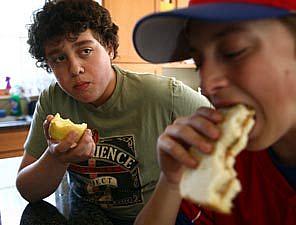Reporting on Childhood Obesity: What I Learned

When my editors asked me to write about childhood obesity and marketing food to kids, we knew it was a hot topic. We also knew it was a BIG topic-so broad that we could go in any number of directions.
This was perhaps the biggest challenge in completing what turned out to be a four-part package, Feeling the Weight, which ran June 12th in The Seattle Times: What, exactly, do we say?
We wound up focusing in four areas: how kids feel about food and weight, how parents feel about their overweight kids, what the government is doing, and how to help your kids. Along the way, we came up with three catch-phrases to sum up the problem: the Temptation Complication, the Cheeto Compulsion, and the Comfort Connection. We also managed to report some things that hadn't been reported elsewhere.
But it wasn't an easy process getting there.
I began by scouring the Internet and reading everything I could on obesity trends and food marketing. I was all over the map. I studied CDC statistics and dense scientific papers and slick reports by food companies. I studied the history of food marketing, learned about efforts to regulate children's TV, and the newfangled ways marketers rope kids in online.
I learned a ton, but I can't say I'd wish this experience on my worst enemy. Did I mention it's a broad topic?
The mantra after that was focus.
Obviously, one thing we needed was individual families. Otherwise, we'd wind up with something sounding like those scientific papers. But finding kids who could talk about their weight struggles-and have their picture appear in the newspaper-was a tough sell. Initially, we tried to find kids through school counselors, doctors, weight-loss programs, even an Internet site where overweight kids gather to share their struggles. Nothing.
Then we decided to post a "teaser" ad online: Is your kid struggling with his or her weight? Thankfully, it worked. We got a lot of response to the ad, and wound up finding several families who were ready, willing and able-and passed a background check.
Meanwhile, I kept talking with the self-proclaimed experts, many of whom seemed to focus on one thing: vegetables. The buzzword was "access." If kids had more access to fresh produce, they would eat it.
The news media seemed to focus a lot of attention on this issue of access, as well. They enthusiastically touted school gardens and farm tours and farmers markets and the like as the answer to the childhood obesity epidemic.
A plate of brownies in the newsroom convinced me this whole access thing was misguided. I mean, really--even if a big bowl of kale was sitting right next to those brownies, I sure as heck wouldn't choose the kale. The brownies would win every time. And brownies (or chips or cookies or ice cream .) are EVERYWHERE.
The problem wasn't access to fresh fruit and vegetables. It's temptation. It's taste. It's the power of salt and sugar to pull us in, to reroute our thinking, and make us want more and more. Kids don't need to eat more produce (in fact, USDA figures show vegetable consumption has remained steady or even increased since the 1970s.) They need to STOP eating the stuff that makes them fat. Yet government programs weren't focusing on this.
Families confirmed that the problem was eating too much, not a lack of access to vegetables. Kids said the same thing, as did former FDA Comissioner David Kessler. School lunch managers said they put out nice salad bars and fresh-cooked meals, yet they can't seem to sell the stuff. Surveys by both government and food marketers confirmed that the vast majority of people have PLENTY of access to fresh fruits and vegetables. Even a major USDA/IOM study said improving access to healthy foods wouldn't put a dent in obesity.
And still the "experts" maintained the same party line: getting vegetables on every street corner would help kids get fit. That's where many programs are spending their money.
Our front page story focused on this disconnect, and readers commented that it was something they hadn't really read before. The county government, which had received a $15 million grant to fight obesity and was spending much of the money on improving access to produce, wasn't happy about the story.
But to me, the most moving part of the project was interviewing parents of overweight kids. To hear them talk about their struggles was not only poignant, it was a point of view I hadn't seen in print elsewhere. Our staff videographer, Danny Gawlowski, upped the ante by getting the parents on camera. He made a separate video of kids.
Now that our own struggle is over-the project is done!-I can say that all-in-all, it's been a great experience. And we couldn't have done it without the help of the Dennis A. Hunt Fund for Health Journalism and the California Endowment.
Read Maureen O'Hagan's project here.
